The American Civil War stands as a pivotal moment in the nation’s history, shaping its destiny and leaving an indelible mark on the collective consciousness of its people. Beyond the battlegrounds and historical accounts, art emerged as a powerful medium to depict the complexities and emotions surrounding this turbulent period. Paintings of the Civil War depict the war’s impact, capturing its heroes, tragedies, and moments of resilience.
From grand battle scenes to intimate portrayals of individuals caught in the storm, these masterpieces capture the essence of the era, bringing to life the poignant stories and sentiments of a nation at war. In this article, we will explore the 10 most famous paintings that chronicle the Civil War era. Let’s delve into the vivid canvas of history and discover the profound impact of these iconic paintings.
At the Front

Artist: George Cochran Lambdin
Year: 1866
George Cochran Lambdin, an esteemed American Victorian artist, gained recognition for his exquisite floral paintings. Born on January 6, 1830, in Pittsburgh, Pennsylvania, he followed in the footsteps of his father, portrait painter James Reid Lambdin. Lambdin honed his skills at the Pennsylvania Academy of the Fine Arts in Philadelphia, showcasing his talent in exhibitions starting in 1848.
During the American Civil War, Lambdin devoted his efforts to the United States Sanitary Commission, providing essential supplies to soldiers on the battlefield. While his earlier works focused on scenes of camp life and domesticity, the horrors of war were not typically within his artistic repertoire.
In 1866, Lambdin created a sorrowful painting titled “At the Front.” This artwork depicts a Union officer, adorned in full uniform, gazing solemnly at the ground. The officer’s expression hints at the profound impact of witnessing the brutalities of combat, leaving an indelible mark on his psyche. Lambdin’s foray into such emotionally charged subjects showcases his versatility as an artist and his ability to evoke deep reflection and empathy through his work.
Prisoners from the Front

Artist: Winslow Homer
Year: 1866
Prisoners from the Front, a renowned painting by Winslow Homer, captures a poignant moment during the Civil War. Completed in 1866, after the war’s conclusion, this artwork portrays a group of Confederate soldiers who have been captured as prisoners of war. At a time when tensions still lingered between individuals from opposing sides, Homer’s painting, titled Prisoners from the Front, offers a glimpse into a specific event from the war.
The scene depicted in the painting is based on a real-life occurrence in June 1864 when Union Brigadier General Francis Channing Barlow apprehended a group of rebel soldiers. Drawing upon his firsthand experience as a war correspondent, he imbued the artwork with a remarkable sense of authenticity and profound depth, capturing the attention and admiration of critics and enthusiasts around the globe. Homer’s reputation soared to new heights in the art world with the creation of this painting, solidifying his standing as a renowned artist.
A notable feature of the painting is the powerful depiction of a Confederate soldier’s defiant expression as he faces off against a Union officer. Behind him, an elderly soldier stands, his hands clasped together in a gesture of anxiety, perhaps reflecting his apprehension regarding the fate of the captured soldiers. Homer masterfully captures the blend of emotions and complexities inherent in war, inviting viewers to contemplate the human experiences and struggles that arise from such conflicts.
Holding the Line at All Hazards

Artist: William Gilbert Gaul
Year: 1882
Painted in 1882 by William Gilbert Gaul, “Holding the Line at All Hazards” stands as one of the most iconic artworks centered around the American Civil War. This powerful painting depicts a brutal battle, capturing the sheer intensity of the conflict. Gaul masterfully portrays the unwavering courage of the Southern soldiers, emphasizing the significance of their flag. Every soldier remains steadfast in their position, refusing to retreat.
In the midst of the chaos, a commanding general stands tall and resolute, clutching his pistol close to his heart, ready to sacrifice everything to hold the line. Gaul’s portrayal associates the Confederate flag not with rebellion but with the bravery and worth of the Confederate soldier.
Unlike many renowned works that feature Union troops engaged in various activities, this painting offers a distinct perspective. It showcases a group of Confederate soldiers fighting with incredible valor, determined to maintain their position and prevent the Union forces from advancing. “Holding the Line at All Hazards” is a poignant testament to the unwavering courage and sacrifice displayed by soldiers on both sides of the Civil War.
The Bright Side
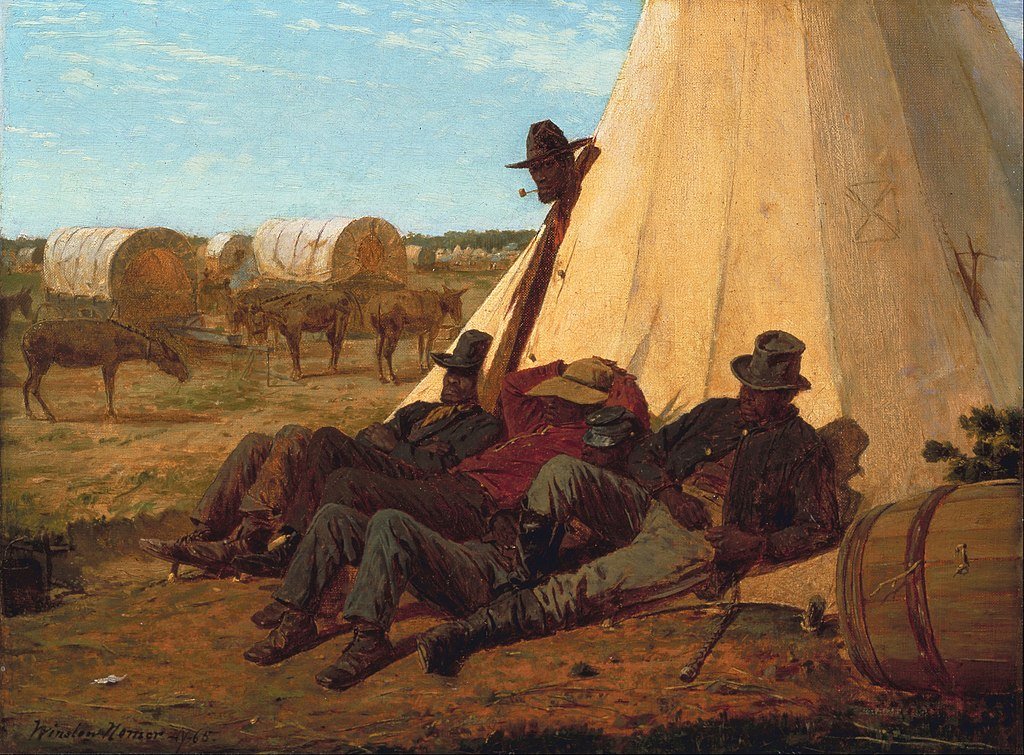
Artist: Winslow Homer
Year: 1865
Painted in 1865 by Winslow Homer, “The Bright Side” captures a captivating scene from the concluding year of the American Civil War. The artwork portrays African American Union Army teamsters, sitting comfortably on the sunny side of a Sibley tent. Four black teamsters exude a sense of dignity and self-assurance, defying any objectifying gaze. One teamster peeks out from the tent, his pipe clenched in his teeth, fixing a piercing glare upon the viewer.
Homer’s depiction reveals his keen perception of formerly enslaved Americans, offering a glimpse of their resilience and strength. Despite receiving lower pay and enduring higher mortality rates compared to their white counterparts, nearly 190,000 African Americans, including free individuals and fugitives, served as Union soldiers. Some worked as teamsters, driving wagons in exposed supply trains targeted by Confederate raiders. If captured, these teamsters faced enslavement or execution. “The Bright Side” captures the spirit of these brave individuals, shedding light on their significant contributions during a tumultuous period in American history.
Grant and His Generals
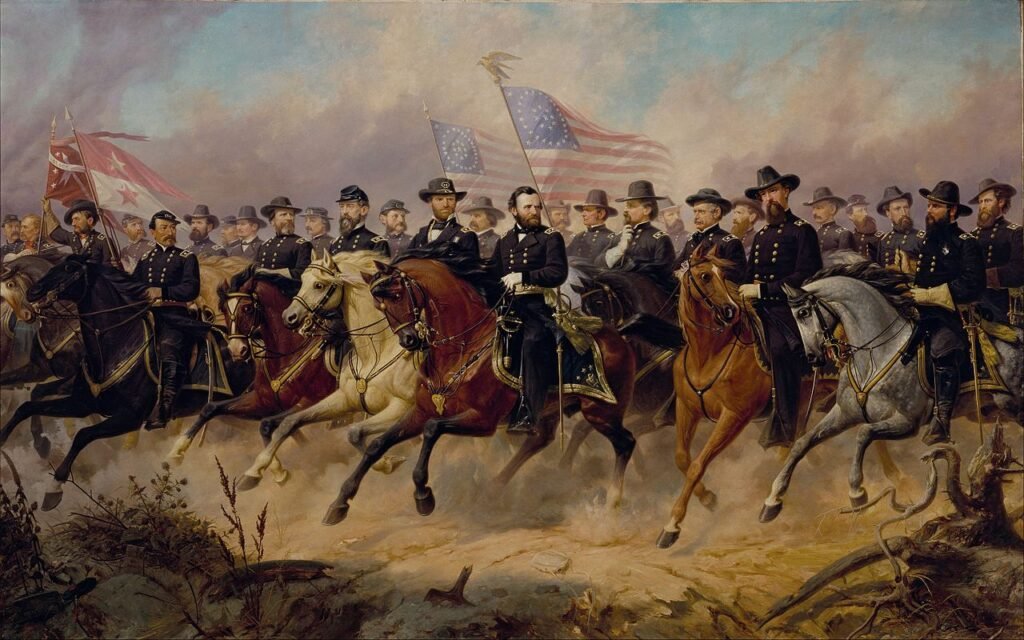
Artist: Ole Peter Hansen Balling
Year: 1865
Painted in 1865 by Ole Peter Hansen Balling, a Norwegian artist who had close interactions with the Union Army’s leadership, including Abraham Lincoln, “Grant and His Generals” stands as an iconic civil war artwork. As the war neared its end, Balling captured the essence of this momentous period in history.
The painting showcases a powerful image of the Union Army’s prominent figures, united in a horseback formation that exudes a sense of triumph and the anticipation of victory. The composition brings together the leaders who played crucial roles in the Union’s military strategy. Balling’s work immortalizes these significant individuals, their collective determination, and the hope they embodied as they rode forward toward the culmination of the war.
The Girl I Left Behind Me
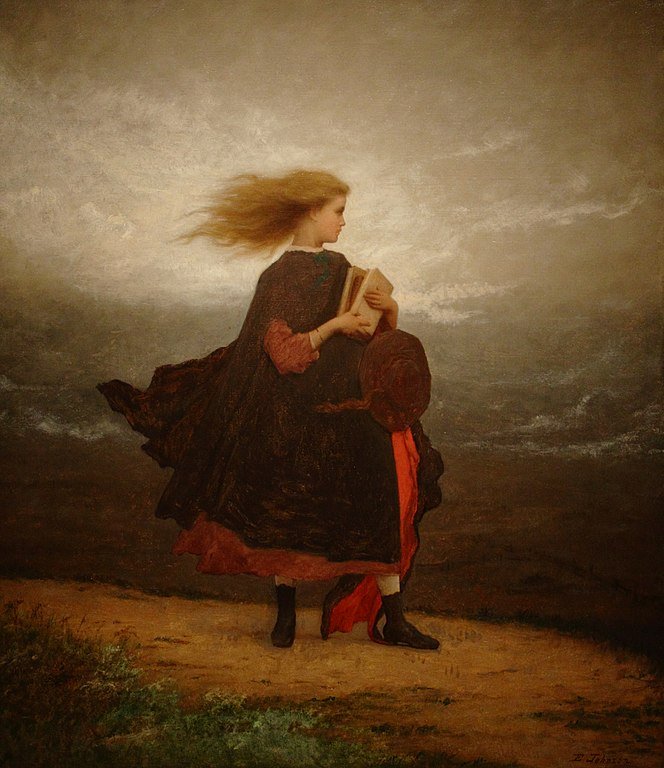
Artist: Eastman Johnson
Year: 1870-75
Eastman Johnson’s renowned painting from the Civil War era, created between 1870-75, stands out for its distinctiveness on various levels. The artwork, aptly named “The Girl I Left Behind Me,” portrays a young and enchanting girl anxiously awaiting her husband’s return, gazing down from a lofty hilltop.
The painting’s title shares its name with an Irish ballad, adding to its emotive resonance. Rather than depicting a tumultuous battle scene or idyllic landscapes observed by military officers, Johnson deliberately captures a poignant and authentic aspect of the war, evoking deep emotions.
The Return of the Volunteer
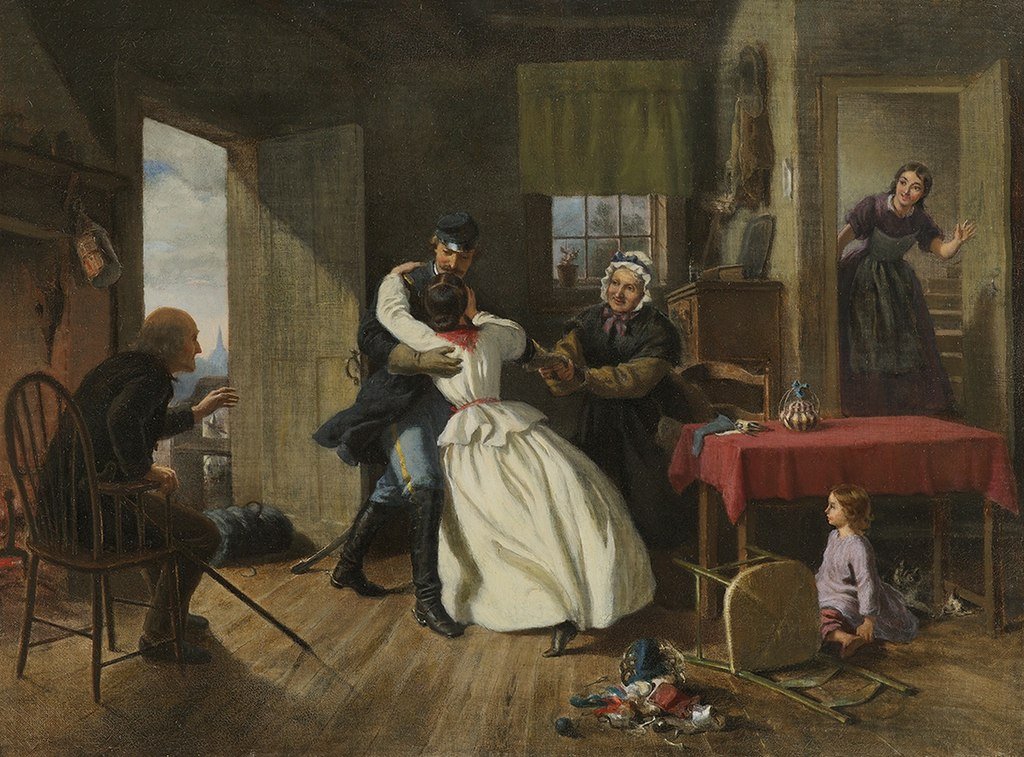
Artist: Felix Octavius Carr Darley
Year: 1865
Painted in 1865 by Felix Octavius Carr Darley, “The Return of the Volunteer” is a captivating oil on canvas artwork. The painting portrays the poignant reunion of a volunteer with his family upon his return from the war. Emotion fills the scene as the soldier embraces his wife with his right arm while holding his mother’s hand with his left hand.
The rest of the family is nearby, their eyes fixed upon the returning hero. Through his artistry, Darley captures the profound sense of relief and joy experienced by the soldier’s family, reflecting the collective emotions felt by loved ones as the war comes to an end. The painting serves as a touching testament to the sacrifices made by soldiers and the significance of family bonds during challenging times.
The Lost Cause
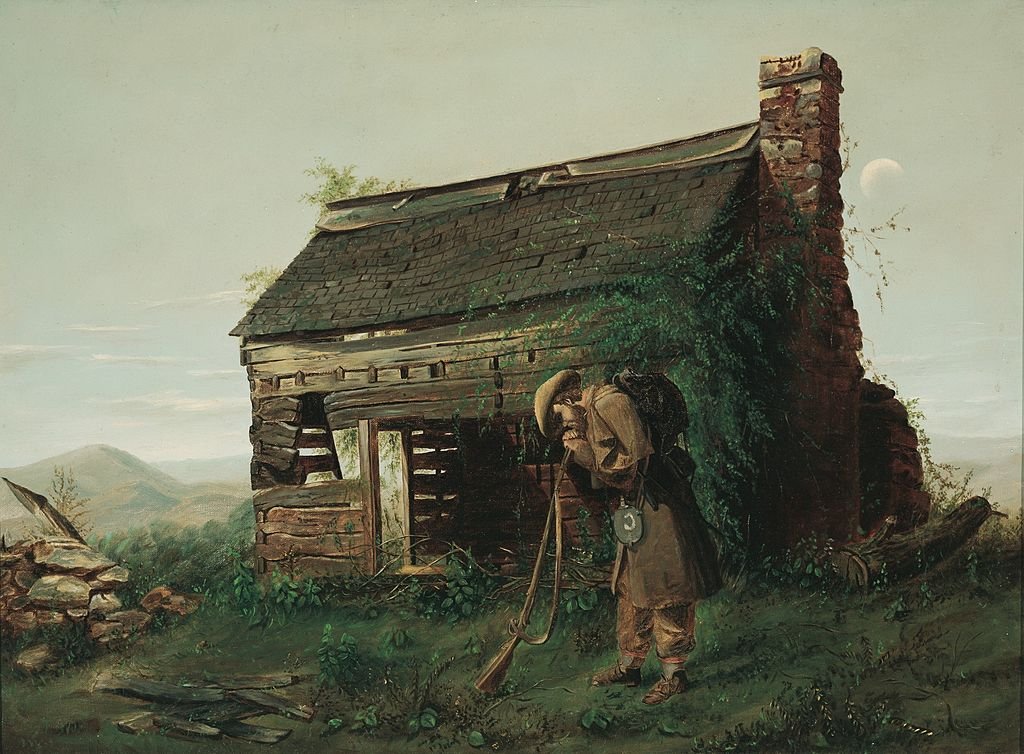
Artist: Henry Mosler
Year: 1868
Painted by Henry Mosler in 1868, “The Lost Cause” is an oil on canvas artwork that encapsulates the complex aftermath of the American Civil War. Reflecting the United States’ search for recovery from the war’s profound political and social upheaval, the painting portrays the allegiance of many Southern citizens to the Confederate States of America.
The Confederate Army united individuals from diverse backgrounds, committed to preserving the Southern way of life. Yet, after four years of conflict, the Confederacy suffered defeat, leading to significant loss and the end of slavery-based society.
As a means to reconcile the scars left by the Civil War, Americans embraced the concept of the “Lost Cause.” This idea, blending historical interpretations and cultural mythology, has permeated various domains, including art, literature, and politics, since 1865. Former Confederates and their descendants utilized the Lost Cause narrative as a means to comprehend their defeat, preserving a sense of honor, self-respect, and an idealized vision of the Southern way of life.
Evening Gun, Fort Sumter

Artist: Conrad Wise Chapman and John Gadsby Chapman
Year: 1864
Collaborating with his father, John Gadsby Chapman, Conrad played a crucial role in the creation of one of the most renowned paintings of the Civil War. Titled “Evening Gun, Fort Sumter,” the painting was completed in 1864 by John Gadsby Chapman, who utilized his son’s meticulous sketches of the heavily damaged Fort Sumter, marking the commencement of the war’s first engagement through intense artillery bombardment.
Conrad Wise Chapman, a young soldier in the Confederate Army, joined the war at the age of 19 and remained a dedicated fighter throughout the conflict, commonly referred to by many Southerners as the “War of Northern Aggression.”
The Battle of the Kearsarge and the Alabama
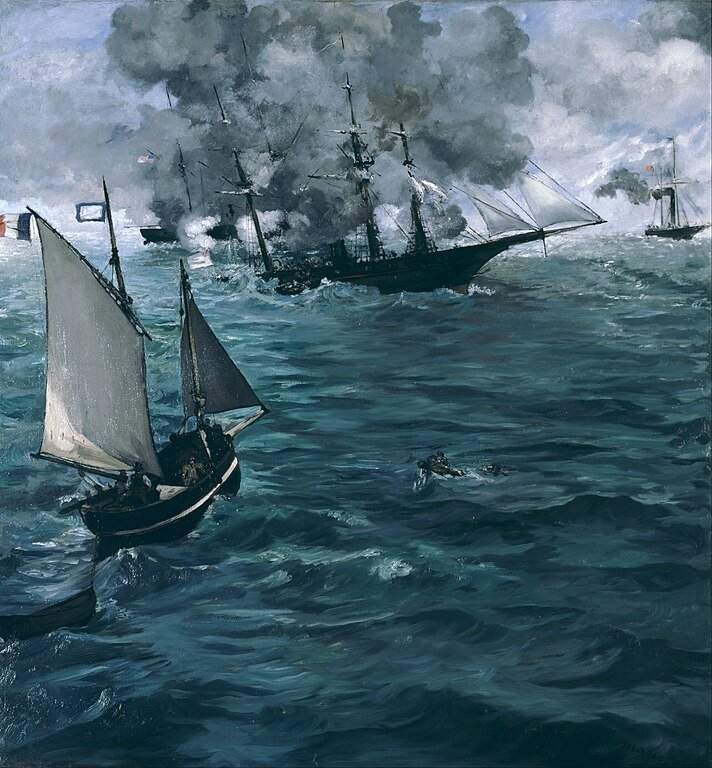
Artist: Edouard Manet
Year: 1864
Édouard Manet’s 1864 oil painting, “The Battle of the Kearsarge and the Alabama,” serves as a commemoration of the naval engagement that took place during the American Civil War, known as the Battle of Cherbourg. The artwork captures the confrontation between the Union cruiser USS Kearsarge and the Confederate raider CSS Alabama.
Although Manet did not witness the battle firsthand, he skillfully relied on press descriptions of spectators along the French coast who were able to witness the USS Kearsarge’s triumph over the CSS Alabama. to bring the event to life in his work. The painting swiftly came to fruition, completed within a month of the battle, and was promptly displayed at the print shop of Alfred Cadart in Paris.
